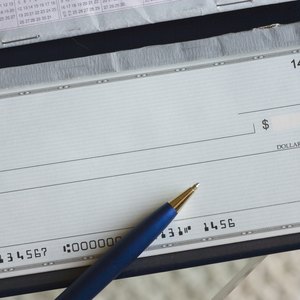
Although personal checks have become less popular due to credit cards, debit cards and electronic banking, folks still use them for paying rent, utilities and other bills. Check writing establishes an easy-to-follow paper trail. You can also use personal checks to withdraw funds from your bank account if you don’t have other options, and you can cash a check made out to you at various check cashing centers. Writing checks to yourself is similar to writing checks to anyone else.
Writing a Check
Begin by writing the current date on the date line in the top right corner (marked by number 2 on the diagram). Write your own name on the payee’s name line – the one preceded by "Pay to the Order Of" (number 3). You can write "Cash" instead of the name of the person receiving the money (i.e., you), but that allows anyone to cash a check, even if lost or stolen.
On the following line (number 5), write (in words) the payment amount of the check, instructs the Consumer Financial Protection Bureau. You can use the format "[x] dollars and [x] cents." Some folks prefer the format "[x] and [xx]/100 dollars," where xx represents the numerals for the cents (for example, express $100.32 as "One hundred and 32/100 dollars").
Next, write the cash amount as a numerical value in the box to the right of the line naming you (or "Cash") as the payee (number 4). On the memo line in the lower left corner (number 6), write the reason for the check. The memo makes it easier to remember why you wrote the check. Finally, sign the check on the signature line (number 7).
You’re now ready to endorse the check.

Endorsing the Check for Deposit
Sometimes, you want to transfer money between your different accounts. For example, you may wish to move money from your checking account to your brokerage account. You can do this by check, although there are better ways to transfer money.
To deposit your check, sign your name on the back and write underneath "For deposit only," explains Bank of America. You should then write in the account number for the account receiving the money.
If you are depositing the check in person, you may have to attach a deposit slip containing:
- The institution’s name (already printed on the slip)
- The institution’s routing number, your account number and your name. You must enter these if you are not using a preprinted deposit slip.
- The date
- A list of one or more check amounts
- The amount of any cash you’d like back
- The total deposit amount
The teller will verify the deposit slip against the check(s) and, if everything is OK, will hand you a receipt detailing the time, date, location, account number (partially disguised) and deposit amount. Look it over before you leave to make sure it's correct.
Endorsing Through Mail and Electronically
You can also make a deposit by mailing your check and deposit slip to the financial institution receiving the funds. ATMs accept check deposits. Nowadays, many no longer need a deposit slip.
You can deposit your check by scanning the front and back on your phone using a mobile online banking app. By entering a few instructions online or via a mobile app, you may find it much easier to forget your checkbook and wire transfer money electronically (through the Automated Clearing House network).
Endorsing the Check for Cash
You can cash a check at a brick-and-mortar bank, credit union, check-cashing store or other designated locations. Your signature endorses the check for cashing. Wait to sign your name on the back of the check until you're about to cash it. Huntington says you should be prepared to show your picture ID to the teller cashing your check, proving you are the account holder.
Some banks limit the amount of newly deposited money you can cash. But that shouldn’t be a problem if you cash the check at your own bank, assuming your account has sufficient funds.
References
Writer Bio
Jonathan Croswell has spent more than five years writing and editing for a number of newspapers and online publications, including the "Omaha World-Herald" and "New York Newsday." Croswell received a Bachelor of Arts degree in English from the University of Nebraska and is currently pursuing a Master's of Health and Exercise Science at Portland State University.

